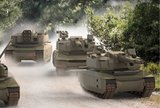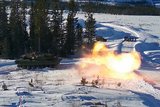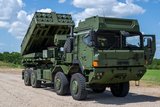Lockheed Martin delivers 400th HIMARS to US Army
The US Army and Lockheed Martin marked the delivery of the 400th High Mobility Artillery Rocket System (HIMARS) during ceremonies today at the company's Camden, Ark., manufacturing facility.
The Army has received 300 HIMARS mobile rocket launchers to date, while the US Marine Corps and international partners have taken delivery of 100 launchers.
"It is absolutely essential that we provide our Soldiers, Marines and Special Operations forces with the most responsive, accurate and lethal long-range fires available. We simply owe our troops nothing short of the best," said Lt. Col. Frederick Hughes, HIMARS product manager for the US Army. "The M142 HIMARS launcher is the system of choice for delivering precision long-range fires for our troops in combat. It is reassuring to know that the King of Battle - the Field Artillery - has 300 HIMARS launchers ready to support our brave men and women defending liberty around the world."
"The HIMARS launcher is in high demand because it's a combat proven system that provides Soldiers and Marines with a reliable, mobile platform to launch precision rockets and missiles," said Scott Arnold, vice president of precision fires in Lockheed Martin's Missiles and Fire Control business. "We're proud the US Army, the US Marine Corps and our international allies depend on HIMARS every day, and consider it an indispensable combat asset."
In service since 2005, HIMARS brings Multiple Launch Rocket System (MLRS) firepower to a wheeled chassis. It carries a single six-pack of rockets or one Army Tactical Missile System (ATACMS) missile, and can launch the entire MLRS family of munitions. It is C-130-transportable and can be deployed into areas previously inaccessible to heavier launchers.
HIMARS also incorporates the self-loading, autonomous features that have made MLRS the premier rocket artillery system in the world. The HIMARS fire-control system, electronics and communications units are interchangeable with the existing MLRS M270A1 launcher, and the crew and training are the same.
Source: Lockheed Martin
More from Land Warfare
-
![Hungary set to begin using Hero 400 loitering munitions]()
Hungary set to begin using Hero 400 loitering munitions
Developed by Israel's Uvision and with systems being sold in the thousands to multiple European NATO countries and the US, the Hero family of loitering systems is also in production in the US and Italy, the latter through Rheinmetall.
-
![Light Reconnaissance Strike – enabling a vital mission set (Studio)]()
Light Reconnaissance Strike – enabling a vital mission set (Studio)
A new system-of-systems concept will unlock digital integration of sensors and weapons for Light Forces, allowing them to shape the battlefield environment on their own terms and upgrade legacy platforms.
-
![Lockheed Martin to look further afield for GMARS rocket system opportunities]()
Lockheed Martin to look further afield for GMARS rocket system opportunities
The HX truck is already in use in many NATO and allied countries around the world as a logistics vehicle and carrier for high-value systems, including missile firing weapons, so its use for the Global Mobile Artillery Rocket System makes logistical sense.






















